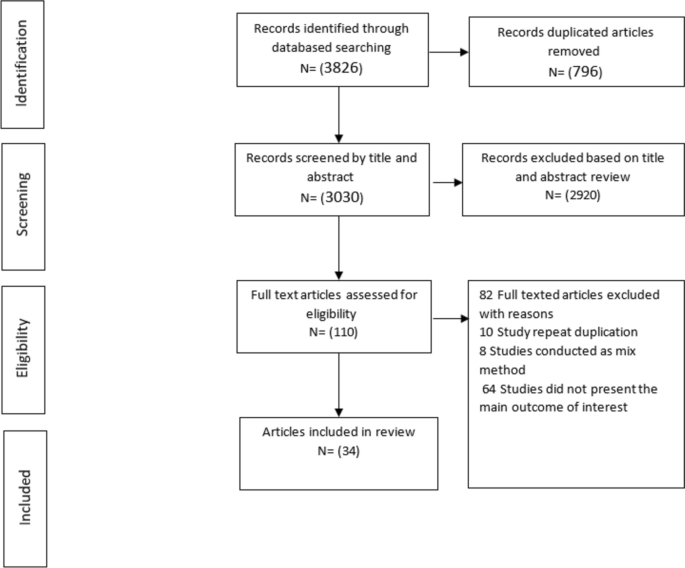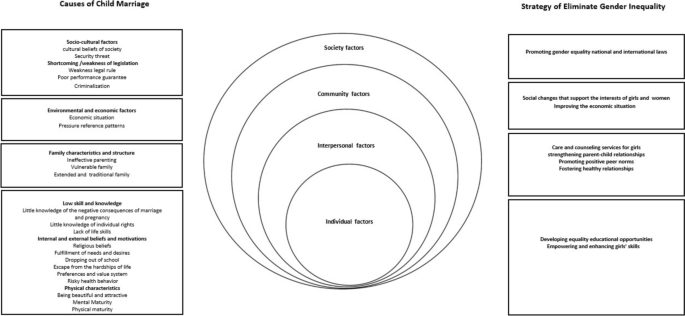The initial search of the database resulted in 3,826 articles. After removing duplicates, titles and abstracts, and full text screening, 34 articles were included in this meta-analysis in checking the reference lists of included studies, no other studies were found (Fig. 2).

PRISMA flow chart diagram describing selection of studies for Meta-synthesis on cause of child marriage
A total of 34 studies were identified in the current review. In total, 14 of the included articles had been conducted in the Middle East [37,38,39,40,41,42,43,44,45,46,47,48,49], 9 in Africa [50,51,52,53,54,55,56,57,58], 8 in South Asia [59,60,61,62,63,64,65,66], 2 in Europe [8, 67],1 in the United States [68], and 1 each in Ethiopia and India [69]. The number of participants ranged from 8 to 300 people. Approximately 900 people participated in the study Table 1.
Risk of bias assessment
All studies that answered affirmatively to the first two questions of the CASP assessment checklist were included. No studies were excluded based on the CASP score. We discussed the results of the quality assessment in regular meetings, resolved our differences, and reached an agreement on 34 studies. In most studies, the study design (n = 33), recruitment strategy (n = 31), data collection methods (n = 29), ethical issues (n = 27), data analysis (n = 23), clear findings (n = 32), and valuable results (n = 31) were explained. In only 8 studies, the relationship between the researcher and the participants was adequately considered Tables S3, S4.
Thematic synthesis
We categorized the socioecological factors of GCM into four levels: The synthesis and contribution of each study are shown in Table 2. Three themes at the individual level (low skills and knowledge, internal and external motivations, physical advantages), one theme at the interpersonal level (family characteristics and structure), one theme at the community level (environmental and economic factors), and two theme at the society level (social and cultural factors, deficiencies/weaknesses of legislation). More details were shown in Table 3 and Fig. 3.

Causes of GCM and proposed strategy to eliminate gender based on Socio- ecological Model
The most salient individual factors of GCM include low skills and knowledge, internal and external thoughts and motivations, and Physical characteristics.
Theme 1: low skill and knowledge
Little knowledge of the negative consequences of marriage and pregnancy
Most of the participants did not have enough information about the consequences of marriage, pregnancy and childbirth. They admitted that they had no idea what to expect when they entered into marriage. They were unprepared and unaware of their new responsibilities as wives and mothers, including housework and taking care of family members [37,38,39, 42, 44, 51, 62,63,64, 68]. “I was really concerned about pregnancy and childbirth.” If I had known that marrying early would lead to such physical and mental problems and ruin my life, I would never have gotten married” [44]. Society appears to be indifferent to girls’ lack of knowledge about marriage and pregnancy. In Morocco, discussions about sexuality are considered social taboos that people, especially young individuals, tend to avoid [51]. One of the informants said, “We do not discuss these matters because of the social stigma. Many boys and girls do not receive comprehensive sex education” [51]. In Iran, there is insufficient media coverage [44] and a lack of counseling and decision-making services for girls [39].
Little knowledge of individual rights
Girls are not aware of marriage laws and sexual rights. Sometimes, the law is disregarded due to a profound lack of awareness among girls and women regarding their rights [51]. One of the informants said, “In rural areas, many child marriages go unreported in the Ministry of Justice’s statistics.” These marriages take the form of a simple ‘Fatiha’ (declaration), remain unregistered, and transform girls into married women without their awareness [51].
Lack of life skills
A lack of independence in decision-making, caused by deficiencies in life skills such as decision-making, problem-solving, negotiation, and critical thinking, expose girls to EM. Some girls felt that they were unable to make informed decisions about marriage due to their inability to anticipate the potential outcomes of their choices. Hence, they accepted the decisions made by their parents [37, 39, 41, 45, 48, 55, 62, 63].“I am not mature enough to judge people’s thoughts and behavior. I didn’t feel good about getting married because I didn’t know my fiancée very well. So I left everything completely to my family” [39].
Theme 2: internal and external motivations
Religious beliefs
James highlighted the inflexible beliefs that prevail in rural society in northern Nigeria. Influenced by these beliefs, teenagers supported the idea of early marriage. One of the girls said, “I support teenage marriage and having children. It’s not a problem. Marriage is a source of pride for women, and it is expected for every Muslim and Christian girl to get married.” Adolescent boys also viewed marriage as a means to fulfill God’s commandments and to follow Western traditions [50]. Girls in the Muslim community of Malaysia also believed that fate decreed that they should marry at a young age. Marriage is an inevitable decree of God that must be obeyed [64].
Fulfillment of needs and desires
Adolescents are in a crisis during their teenage years. Neglecting them and their needs can lead to engaging in risky behaviors and EM [70]. Gaining independence and freedom, seeking significance, the desire to form relationships with the opposite sex, and the longing for a life partner are some of the factors that motivate girls to marry at a young age [71, 72]. In addition, in Muslim countries, the sexual needs of girls can only be fulfilled through marriage and within the framework of religious and customary [73]. In the Kurdish regions of Iran, cultural and social beliefs contribute to a more favorable perception of young brides and greater support for them. As a result, they often receive larger dowries. “In our region, when we are younger, there is often more emphasis on dowry, but I did not want to get married at all” [44]. In Morocco, many girls aspire to marry someone residing in Europe. They have idealized images of a wonderful life abroad in their impressionable minds. “The marriage market acquired on a dimension, element, as many women aspire to marry marrying a Moroccan residing living Europe” [51]. Marriage may not always be in the best interest of a girl, but it can be a strategic choice for her, given the current situation.
Dropping out of school
In rural and impoverished areas, families cannot afford the direct costs of education such as tuition and books, as well as the indirect costs of transportation or accommodation at distant middle schools. Additionally, they were uncertain about future career prospects. In this case, the girls voluntarily dropped out of school to help with household chores [37, 47, 52, 57]. Also, the negative attitude towards girls’ education, preservation of cultural values [37, 44, 55, 65], lack of interest in education [52, 56, 57], poor academic performance [55], war and displacement [40] have reduced the educational opportunities for girls and have provided grounds for EM . One of the Syrian refugees said, “We used to enjoy studying and getting married, but now we are affected by the Syrian war”. The situation has changed [40].
Escape from the hardships of life
The participants used marriage as an avoidance coping strategy to escape the difficulties of life. In most cases, poverty was seen as an integral part of challenging living conditions. Syrian refugees in Lebanon described their dire financial situation, living in small tents, in unsanitary and insecure conditions as difficult and exhausting. In order to escape these conditions, they resorted to marrying off their young girls [40]. In Somalia, environmental degradation and frequent particularly especially in rural along with and war, result in make girls becoming girls victims of early and forced marriages. One of the girls said, “Perhaps when I marry a wealthy older man, I will continue my education, as all my needs such as educational materials, school fees, and travel expenses will be covered by him” [43].
Preferences and value system
The characteristics of suitors, such as their occupation, social status, and personal background, were factors influencing the children’s choice of spouse. They believe that suitable marriage opportunities should not be missed [37,38,39,40,41,42, 44, 45, 52, 59, 63, 66, 67]. Girls also welcomed the opportunity to marry a good suitor. “I feel very fortunate to have such a good, intelligent, and caring person in my life. I believe that girls should marry at a younger age, provided it’s a suitable match “ [38].
Risky health behavior
Some of the girls in this study indicated that they had been involved in high-risk activities during their teenage years, such as drinking and using drugs with their peers [64]. Through a network of friends, they found a partner with whom they had sexual intercourse and became pregnant. In order to conceal shame and scandal, the family compelled the girl to enter into an immediate marriage in accordance with Sharia standards [8, 45, 52, 55,56,57, 59,60,61,62,63,64,65, 67, 68]. “We engaged in sexual activity before marriage, even though it was wrong. “Then I found out I was pregnant while I was working [64].”
Theme 3: physical characteristics
Being beautiful and attractive
Young and attractive girls were more attractive to men [37, 44, 57, 59]. The desire of men to marry young and beautiful girls has created a fear within families that if their daughters grow up, no one will want to marry them, which would bring shame to the family [61, 69], Some boys deceive and have sex with them. “I’m a pretty girl, and a lot of guys were attracted to me”. I learned that if I don’t get married, I might end up in a situation involving sex outside of marriage [39].
Mental maturity
Maturity is a sign of readiness for marriage. Some girls believed they were more sensible than their peers, so they agreed to get married [39, 67, 69]. “Marriage was very important to my family. My mother told me that I am no longer a little girl after getting married. I will become more mentally mature than before. I have more plans for the future” [39].
Physical maturity
Parental illiteracy and adherence to cultural norms expose girls to EM. According to religious and cultural standards, girls who have reached a certain age, started menstruating and developing breasts, are eligible for marriage. One of the girls said, “People think that when a girl grows up physically, she is ready to marry” [39].
The characteristics and structure of the family are the most important interpersonal factors that provide the foundation for GCM.
Theme 4: family characteristics and structure
Ineffective parenting
Ineffective parenting jeopardizes the bond between parents and children. Sometimes this relationship is influenced by parental concerns. Families concerned about their child engaging in premarital sex may consent to the marriage of their daughters at a young age [8, 46, 49, 54, 66]. Sometimes, the parent-child relationship is influenced by the parents’ irresponsibility [50, 59, 61], incompatibility [48], and ignorance of the child’s interests [55]. In Ineffective families, children may have to compete with each other for their parents’ attention or affection, which can also influence their decisions about marriage. One of the girls said, “Our family was not warm and strong. We lacked affection with my sister so much that we fell in love with cartoon characters. We wanted to marry and live with them” [48].
Vulnerable family
A family atmosphere is an important factor in shaping children’s attitudes towards marriage. The family provides a safe haven for the children, where they can grow surrounded by the love and attention of their parents. In families that lack stability, children may experience harmful effects such as CM, behavioral issues, emotional disturbances, and moral abnormalities. If children lose the support of their parents due to reasons such as the death of their parents, divorce, addiction, or violence, they may prefer to marry at a young age, or their parents may consent to their marriage due to behavioral indecisiveness. said one of the girls [48, 49]. One of the girls said, “I was thinking, ‘God, can I get married one day and be free from this family?” [48].
Extended and traditional family
Extended and traditional families usually have a large population [44, 52]. The decision-making frameworks in these families are made by social norms and values, and all the decision-making processes are assigned to men [44, 45, 48, 51, 59]. In these families, the father’s relatives can decide on the marriage of daughters as much as the father [41, 51]. “My father did not ask me if I want to get married or not. (My father decided on my marriage)” [48].
Community factors related to GCM included environmental and economic aspects.
Theme 5: environmental and economic factors
The economic situation
Most of the participants cited the challenging economic situation and poverty as reasons for marrying at a young age. Poverty, financial burden, lack of family support, inability to meet basic needs, challenging living conditions [39, 42, 45, 47, 52, 54, 56, 57, 59, 61, 63,64,65], poverty resulting from climate change [43], and lack of employment opportunities [51] are all factors that contribute to EM. Some of them were not passive victims of their life circumstances, but actively trying to solve the problems in their lives. They decided to get married. “If I get married, I will feel like a bird leaving the prison. I will transform into a butterfly that soars toward freedom and happiness. “I will also assist my mother because she will have one less child to worry about” [67].


